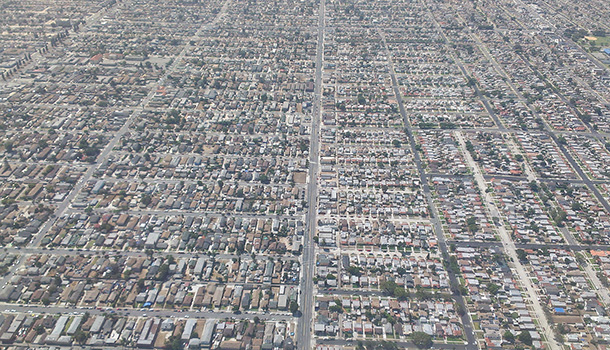
South Los Angeles (Photo: Alfred Twu/Wikimedia)
The federal Opportunity Zone program represents a unique opportunity to channel private investment into California communities most in need. In order to take full advantage of this tool, California should do what states have done and ensure that the state tax code conforms to the federal tax treatment. California’s window for taking this step — allowing the state to compete nationally and direct investment to critical housing and clean energy projects — is rapidly closing.
As the most populous state in the country and world’s fifth largest economy, California is uniquely positioned to leverage its diverse regions and industries to maximize economic gain. However, as elsewhere in the U.S., not all communities have benefited equally from the state’s overall economic prosperity. Historically underserved communities struggle to attract investment that can help build the housing and job centers that are needed statewide. The federal Opportunity Zone program, which allows for tax-advantaged long-term investments of realized capital gains in designated low-income census tracts, presents an opportunity to help those communities gain traction and channel private investment into projects that benefit local residents.
In 2018, California Economic Summit participants developed a framework to ensure local communities are opportunity zone ready and identify a state role through the alignment of complementary programs and removal of regulatory barriers that would hamper local implementation. CA Fwd has continued to build on this work through its partnership with CalOZ and other organizations to identify ways state and local governance can help attract investment that maximizes community benefit in CAQOZs.
California has 879 Opportunity Zones, approximately 10% of the national total, selected based on local input and income requirements. California qualified opportunity zones (CAQOZs) are home to more than 3 million residents, represent 25% of low-income communities in the state and are dispersed through 57 of its 58 counties. This spring CA Fwd and Golden State Opportunity released a study indicating that between $745 million and $1.2 billion of new economic activity could be generated in Opportunity Zones this year alone, with additional activity in subsequent years.
In addition to making sure California remains competitive with other states that have ensured conformity, this step allows the state and local government to bolster support for the projects that stand to benefit CAQOZ communities the most.
The Newsom Administration has proposed granting state tax conformity for projects including low- and moderate-income housing and green technology and would also include reporting requirements to allow the state and outside parties to gauge the effectiveness of the OZ program in attracting projects that benefit low-income communities. This proposal has sufficient guardrails to prevent abuses that have been part of tax preferences in the past.
Previous programs designed to achieve similar outcomes have increased skepticism of the value of the Opportunity Zone program to the communities they are meant to serve, but there are concrete examples of the positive impact of OZs in the state and across the country that serve as an example of what is possible. In California, the cities of Stockton and Los Angeles in particular have embraced OZs to the benefit of their communities. Stockton has partnered with San Francisco startup Neighborly to construct a broadband network for the city utilizing OZ financing. In Los Angeles, housing developer SoLa Impact is planning new housing units and commercial space in economically distressed South LA after raising $100 million through its Opportunity Zone Fund.
The legislature is in its final week of the 2019 legislative session and will adjourn on Friday, September 13. It is essential that communities with designated Opportunity Zones contact their legislators and drive home that this proposal will help facilitate the projects that can serve as stepping-stones to greater economic mobility.

